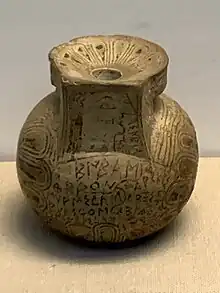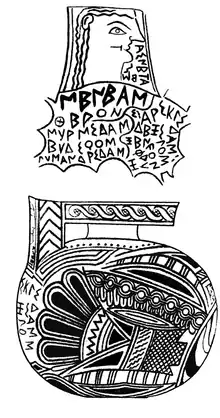| Aineta aryballos | |
|---|---|
 The Aineta aryballos displayed in the British Museum | |
| Material | Ceramic |
| Size | 6.35 centimetres (2.50 in) (height)[1] |
| Writing | Ancient Greek (Corinthian alphabet) |
| Created | disputed; c. 625 – c. 570 BCE |
| Discovered | c. 1852 Corinth, Greece |
| Present location | British Museum |
| Identification | 1865,1213.1 |
The Aineta aryballos is an Ancient Greek aryballos, made in Corinth between approximately 625 and 570 BCE. Approximately 6.35 centimetres (2.50 in) in both height and diameter, it was intended to contain perfumed oil, and is likely to have been owned by a high-class courtesan (hetaira) by the name of Aineta, who may be portrayed in a drawing on its handle. The vase's illegal sale to the British Museum in 1865 led to the prosecution of its seller, the Athenian art dealer Athanasios Rhousopoulos, and exposed the latter's widespread involvement in antiquities crime.
The vase is inscribed with a portrait, generally agreed to be that of a woman and probably that of Aineta, who is named in the inscription upon the vase. Below the portrait are the names of several men, generally taken to be Aineta's admirers or lovers. It is likely to have been found in a grave, probably that of Aineta herself. According to Rhousopoulos, it was discovered in Corinth around 1852. In 1877, Panagiotis Efstratiadis, the Ephor General of Antiquities in charge of the Greek Archaeological Service, had Rhousopoulos fined for selling the vase in contravention of Greek law. The case has been called "a milestone in the trafficking of Greek antiquities", in that it represented a relatively rare successful use of state power against the illegal trade in Ancient Greek artefacts.[2]
Description
The vase is made from yellowish clay, described by Rhousopoulos as "rather rough, but diligently cleaned".[3] It is approximately 6.35 centimetres (2.50 in) in height[1] and diameter. Its base is flat, allowing it to stand on its own.[4] In his publication of the aryballos, Rhousopoulos said that it resembled a quince;[4] later, he would describe it as "the size of an apple".[5]
The opening of the jar is approximately 8 millimetres (0.31 in) in diameter, within a 'mouth' approximately 4.2–4.8 centimetres (1.7–1.9 in) in diameter. The handle is 3.0 centimetres (1.2 in) wide and 2.5 centimetres (0.98 in) tall, and tapers slightly towards the bottom. The vase body, the neck and the handle were made separately and joined using a lathe.[4]
Aryballoi were typically used to store small amounts of perfumed oil. Rhousopoulos believed that the vase may have been a gift to a high-class courtesan (hetaira) named Aineta from her lovers, or perhaps deposited as a grave good in her tomb.[lower-alpha 1] In support of this hypothesis, Rhousopoulos suggested that the vase's excellent state of preservation, as well as the lack of any post-manufacture inscriptions (such as the kalos inscription common on ancient Greek vases) indicated that it had never been used.[6] The archaeologist Rudolf Wachter concurs with Rhousopoulos's assessment that the vase was likely a "love-gift".[7]
Decoration and date
The body and mouth of the vase are decorated with rosettes. Rhousopoulos considered the mouth of the aryballos, with its flower-like motif centred on the opening, as the finest part of the vase, writing "here we trace a fully Greek taste". However, he contrasted this with the decoration of the vase body, where, he judged, "we immediately find ourselves in unknown regions of Asia: magnificent, ... but strange and exotic".[8]
On the basis of its decoration, Rhousopoulos dated the vase to the 30th Olympiad (660–656 BCE), which would have made the Aineta aryballos the oldest-known inscribed Corinthian vase.[9] This would place it in the ceramic period known as Middle Protocorinthian II.[10] Its date has since been disputed: in his 1931 work on Corinthian pottery, Humfry Payne dated it to approximately 625 BCE on the basis of the letter-forms used in the inscription, an assessment endorsed by the archaeologist Lilian Hamilton Jeffery in 1961.[11] In 1979, the ceramicist Fritz Lorber dated it to the Early Corinthian period (620/615–595/590 BCE).[12] The art historian Darrell A. Amex suggested in the 1980s that it more likely dates to the Middle Corinthian period (595/590–570 BCE), a view upheld as the most probable by Wachter.[13]
Inscription

The handle of the vase is inscribed with a drawing of the head of a woman, with a list of men's names on the vase body below it.[14] Ten men are named in total, each on an individual line.[7] All of the names, as well as the drawing, were inscribed at the time of the vase's manufacture.[6] Descending from the mouth of the woman's portrait is an inscription, Αἰνέτα ἐμί (Aineta emi): the word emi[lower-alpha 2] means "I am", and Aineta is a name, meaning 'the famous one' or 'the praised one'.[15] It is generally considered to be a woman's name, probably of a hetaira, as it fits the common tendency for hetairai to have self-descriptive "speaking names".[16] Scholars debate whether Aineta is in the nominative case or the genitive case: if the former, the inscription translates to "I am Aineta"; if the latter, it means "I am Aineta's". In support of the nominative reading, Wachter and the archaeologist Margherita Guarducci point out that it is written descending from the portrait's mouth, as if representing the woman's speech.[17]
In the 1970s, the archaeologist Carlo Gallavotti argued that the portrait was that of a man's head, that the name was that of Ainetas, a male dancer, and that the other names were members of his troupe, including a musician named Menneas.[18] This view has generally been rejected;[19] Payne had earlier dismissed the "Ainetas" hypothesis on the grounds that the name is otherwise unknown in Greek.[20] Aineta is sometimes considered to be a pseudonym or the name of a fictional hetaira, though Wachter considers it most likely to be real.[16] The name Menneas, which comes first in the list and is written slightly larger and more boldly than the others, seems to have been given particular prominence.[7]
Rhousopoulos interpreted the female face as a drawing of the goddess Aphrodite.[6] Most subsequent assessments have considered it more likely to be a portrait of Aineta herself.[15] Milne considered that the presence of multiple male names showed a "co-operative spirit" between Aineta's admirers, and contrasted the vase with another excavated in Corinth in 1872, which showed three female names that she suggested were those of hetairai.[21] Wachter has described the list of male names as good evidence for Corinthian prosopography and onomastics at the time of the vase's use.[7]
Discovery
The vase was first mentioned in scholarship by the Greek antiquities dealer Athanasios Rhousopoulos, in an 1862 article in the journal of the German Archaeological Institute at Rome.[22] According to Rhousopoulos's publication, the vase had been discovered around 1852 in Corinth, and had "come into [his] possession" a few years later.[4]
Rhousopoulos was a part of the illegal trade in ancient artefacts excavated surreptitiously and without official permission.[23] In the early 1870s, he boasted to the Oxford professor George Rolleston that he was able to call upon "all the Athens grave-diggers[lower-alpha 3] who dig for tombs throughout Attica".[26] Though his activities had not yet attracted official notice,[5] the archaeological historian Nikolaos Papazarkadas has written that Rhousopoulos "was heavily involved in dubious transactions involving illegally-excavated antiquities".[23] The main law governing antiquities was the Archaeological Law of 22 May [O.S. 10 May] 1834,[lower-alpha 4] which has been described as "loosely interpreted and even more loosely enforced".[28] Under the 1834 law, private excavators – often known as "grave-robbers"[29] – required the permission of the Ephor General to excavate, but the Ephor General was obliged to grant that authorisation if the excavation took place on private land and had the landowner's consent.[30] Furthermore, antiquities discovered in such excavations were considered the joint property of the state and the private excavators,[31] and would be shared between the landowners and the excavators.[32] Such artefacts could be sold freely overseas, provided that their owners secured the judgement of a state committee of three experts that the object was "useless" to Greek museums.[33]
Sale to the British Museum

In 1865, Efstratiadis, by this point the Ephor General in charge of the Greek Archaeological Service,[lower-alpha 5] wrote in his diary of the size and richness of Rhousopoulos's antiquities collection, marking the first time that Rhousopoulos's activities had come to official attention.[5] Rhousopoulos sold the aryballos to the British Museum for 1,000 drachmae in 1865,[2][lower-alpha 6] via Charles Merlin, a British banker and diplomat resident in Athens who often acted as an intermediary for antiquities purchases. Charles Newton, the museum's Keeper of Greek and Roman Antiquities, had previously selected the object for purchase, and subsequently received it from Merlin.[36] Rhousopoulos made the sale without securing the required permission from the state committee, but wrote to defend himself in the newspaper Elpis (Ελπις) on 16 February [O.S. 4 February] 1867, arguing that the aryballos was "of no artistic value, the size of an apple, only valued for 25 drachmae".[5][lower-alpha 6] Efstratiadis, meanwhile, denounced Rhousopoulos as a "university professor; antiquities looter".[37]
Efstratiadis's ability to respond to Rhousopoulos's breach of the law was limited: the state had limited financial, human and legal resources to address the illegal excavation and trade of antiquities, and his superiors in government had little political will to do so.[38] He also needed to maintain good relations with Athens's art dealers, who undertook more excavations in this period than either the Greek Archaeological Service or the closely-aligned Archaeological Society of Athens, and usually offered to sell the artefacts they uncovered to the state.[39] Furthermore, Rhousopoulos was periodically a member of the appraising committee of three, and often acted as a consultant to it, further limiting Efstratiadis's ability to use the state's archaeological apparatus against him.[29]
Rhousopoulos was, however, fined 1,000 drachmae (the same as the price for which he had sold the aryballos) later in 1867 for exporting antiquities without the Ephor General's permission.[40] His actions were condemned by the Minister for Education and Religious Affairs, who oversaw the Archaeological Service,[40] and by the Archaeological Society of Athens, which expelled him at some point in the 1870s.[41] Rhousopoulos subsequently endeavoured to keep his antiquities dealing outside the knowledge and scrutiny of the state.[40] The archaeologist Yannis Galanakis has called the case over the aryballos "a milestone in the trafficking of Greek antiquities", in that it represented a rare successful prosecution for the unauthorised export of an ancient artefact under the 1834 law.[2]
Footnotes
Explanatory notes
- ↑ Rhousopoulos attributed the latter idea to the German archaeologist Otto Jahn.[6]
- ↑ In Attic Greek, written as εἰμί (eimi); the ἐμί spelling is attested on other Corinthian vases.[7]
- ↑ In Greek, τυμβωρύχοι (tymborychoi). The archaeologists Yannis Galanakis and Stella Skaltsa point out that this word literally means grave-diggers, but that it had carried negative connotations of robbery since antiquity and, by the 1870s, "clearly referred to people who dig up tombs in order to despoil them".[24] However, Galanakis and Nowak-Kemp elsewhere note that the term could also be used more neutrally, since τυμβωρύχοι often worked on legal excavations with the permission of the Ephor General.[25]
- ↑ Greece adopted the Gregorian calendar in 1923; 28 February [O.S. 15 February] was followed by 1 March.[27] In this article, this date and all subsequent dates are given in the 'New Style' Gregorian calendar, while dates before it are given in the 'Old Style' Julian calendar.
- ↑ Efstratiadis had assumed the office in 1864, following the death of Kyriakos Pittakis.[34]
- 1 2 By way of comparison, Rhousopoulos earned 350 drachmae a month from his professorship at Athens in 1859.[35]
References
- 1 2 British Museum 2020.
- 1 2 3 Galanakis 2012b.
- ↑ Rhousopoulos 1862, p. 47.
- 1 2 3 4 Rhousopoulos 1862, p. 46.
- 1 2 3 4 Galanakis 2012e.
- 1 2 3 4 Rhousopoulos 1862, p. 55.
- 1 2 3 4 5 Wachter 2001, p. 48.
- ↑ Rhousopoulos 1862, p. 47: Qui rintracciamo un gusto pienamente greco, ma, fatto un piccolo salto dal disco sul corpo del vaso, subito ci ritroviamo in regioni ignote dell' Asia, magnifiche sì, ma strane ed esotiche
- ↑ Rhousopoulos 1862, p. 56.
- ↑ Hasaki 2021, p. 78 (table 3.4), based on Amyx 1988, pp. 399, 428.
- ↑ Jeffery 1961, pp. 125, 131, cited in Wachter 2001, p. 47.
- ↑ Lorber 1979, pp. 28–30, cited in Wachter 2001, p. 47; for the date, Hasaki 2021, p. 78 (table 3.4), based on Amyx 1988, pp. 399, 428.
- ↑ Amyx 1988, p. 561; Wachter 2001, p. 47.
- ↑ Wachter 2001, p. 47.
- 1 2 Wachter 2001, pp. 48, 260.
- 1 2 Wachter 2001, p. 260.
- ↑ Wachter 2001, p. 48; Guarducci 1978, p. 400.
- ↑ Gallavotti 1976, p. 222; cited in Wachter 2001, p.48, n. 181.
- ↑ Wachter 2001, p.48, n. 181.
- ↑ Payne 1931, p. 162.
- ↑ Milne 1942, pp. 217, 222.
- ↑ The article is Rhousopoulos 1862.
- 1 2 Papazarkadas 2014, p. 406.
- ↑ Galanakis & Skaltsa 2012, p. 638.
- ↑ Galanakis & Nowak-Kemp 2013, n. 39.
- ↑ Galanakis & Nowak-Kemp 2013, p. 3.
- ↑ Kiminas 2009, p. 23.
- ↑ Galanakis 2011, p. 186.
- 1 2 Galanakis 2012c.
- ↑ Galanakis & Skaltsa 2012, p. 623.
- ↑ Petrakos 2011, p. 18.
- ↑ Galanakis & Skaltsa 2012, p. 640.
- ↑ Galanakis & Nowak-Kemp 2013, pp. 6–7.
- ↑ Petrakos 2011, p. 63.
- ↑ Galanakis & Nowak-Kemp 2013, n. 32.
- ↑ Galanakis 2012d.
- ↑ Galanakis & Nowak-Kemp 2013, p. 16.
- ↑ Galanakis 2011, p. 193.
- ↑ Galanakis 2011, p. 177.
- 1 2 3 Galanakis & Nowak-Kemp 2013, p. 8.
- ↑ Galanakis 2012a.
Bibliography
- Amyx, Daryll Arlynn (1988). Corinthian Vase-Painting of the Archaic Period: II: Commentary: The Study of Corinthian Vases. California Studies in the History of Art. Berkeley, Los Angeles and London: University of California Press. ISBN 978-0-520-03166-1.
- British Museum (28 April 2020). "Aryballos". Archived from the original on 5 February 2023. Retrieved 8 May 2023.
- Galanakis, Yannis; Nowak-Kemp, Malgosia (2013). "Ancient Greek Skulls in the Oxford University Museum, Part II: The Rhousopoulos–Rolleston Correspondence". Journal of the History of Collections. 25 (1): 1–17. doi:10.1093/jhc/fhq040.
- Galanakis, Yannis; Skaltsa, Stella (2012). "Tomb Robbers, Art Dealers, and a Dikast's Pinakion from an Athenian Grave". Hesperia. 81 (4): 619–653. doi:10.2972/hesperia.81.4.0619. JSTOR 10.2972/hesperia.81.4.0619. S2CID 163987166.
- Galanakis, Yannis (2011). "An Unpublished Stirrup Jar from Athens and the 1871–2 Private Excavations in the Outer Kerameikos". Annual of the British School at Athens. 106: 167–200. doi:10.1017/S0068245411000074. JSTOR 41721707. S2CID 162544324.
- Galanakis, Yannis (17 October 2012). "Guns, Drugs, and the Trafficking of Antiquities: Archaeology in 19th-century Greece". Center for Hellenic Studies Research Bulletin. Harvard University. Archived from the original on 31 March 2023. Retrieved 30 March 2023.
- Galanakis, Yannis (31 December 2012). "'Insignificant', 'Superfluous' and 'Useless': Legal Antiquities for Export?". Center for Hellenic Studies Research Bulletin. Harvard University. Archived from the original on 26 January 2023. Retrieved 8 May 2023.
- Galanakis, Yannis (15 November 2012). "Of Grave Hunters & Earth Contractors: A Look at the "Private Archaeology" of Greece". Center for Hellenic Studies Research Bulletin. Harvard University. Archived from the original on 31 March 2023. Retrieved 5 May 2023.
- Galanakis, Yannis (30 November 2012). "On Her Majesty's Service: C.L.W. Merlin and the Sourcing of Greek Antiquities for the British Museum". Center for Hellenic Studies Research Bulletin. Harvard University. Archived from the original on 4 February 2023. Retrieved 5 May 2023.
- Galanakis, Yannis (31 October 2012). ""University Professor – Antiquities Looter"?". Center for Hellenic Studies Research Bulletin. Harvard University. Archived from the original on 31 March 2023. Retrieved 5 May 2023.
- Gallavotti, Carlo (1976). "Il balletto di Purrias" [The Ballet of Purrias]. Rendiconti della Classe di Scienze Morali, Storiche e Filologiche dell'Accademia dei Lincei (in Italian). 31: 219–222.
- Guarducci, Margherita (1978). "Ancora di epigrafi greche arcaiche: III" [More Ancient Greek Inscriptions: III]. Rendiconti della Classe di Scienze Morali, Storiche e Filologiche dell'Accademia dei Lincei (in Italian). 33: 397–402.
- Hasaki, Eleni (2021). Potters at Work in Ancient Corinth: Industry, Religion and the Penteskouphia Pinakes. Princeton: American School of Classical Studies at Athens. ISBN 978-0-87661-553-9.
- Jeffery, Lilian Hamilton (1961). The Local Scripts of Archaic Greece. Oxford: Oxford University Press. ISBN 978-0-19-814061-0.
- Kiminas, Demetrius (2009). The Ecumenical Patriarchate. San Bernardino: The Borgo Press. ISBN 978-1-4344-5876-6.
- Lorber, Fritz (1979). Inschriften auf korinthischen Vasen [Inscriptions on Corinthian Vases] (in German). Berlin: Deutsches Archaologisches Institut. ISBN 978-3-7861-1180-1.
- Milne, Marjorie (1942). "Three Names on a Corinthian Jar". American Journal of Archaeology. 46 (2): 217–222. doi:10.2307/499384. JSTOR 499384. S2CID 191354944.
- Papazarkadas, Nikolaos (2014). "Epigraphy in Early Modern Greece". Journal of the History of Collections. 26 (3): 399–412. doi:10.1093/jhc/fhu018.
- Payne, Humfry (1931). Neocorinthia: A Study of Corinthian Art in the Archaic Period. Oxford: Oxford University Press. OCLC 2800964.
- Petrakos, Vasileios (2011). Η εν Αθήναις Αρχαιολογική Εταιρεία. Οι Αρχαιολόγοι και οι Ανασκαφές 1837–2011 (Κατάλογος Εκθέσεως) [The Archaeological Society of Athens. The Archaeologists and the Excavations 1837–2011] (in Greek). Athens: Archaeological Society of Athens. ISBN 978-960-8145-86-3.
- Rhousopoulos, Athanasios Sergiou (1862). "Sopra un vasetto corinzio con iscrizioni d'un carattere antichissimo" [On a Small Corinthian Vase with Inscriptions of a Most Ancient Character]. Bullettino dell'Instituto di Corrispondenza Archeologica (in Italian). 34: 46–56. Retrieved 7 May 2023.
- Wachter, Rudolf (2001). Non-Attic Greek Vase Inscriptions. Oxford: Oxford University Press. ISBN 978-0-19-814093-1.